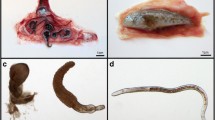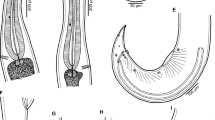Abstract
Two closely related parasites, Anguillicola crassus and Anguillicola novaezelandiae, originally parasitizing swim bladders of the Japanese eel (Anguilla japonica and the Short-finned eel (Anguilla australis), respectively, were used for analyzing the infection success of each parasite species on either long-known, recently acquired or new definitive host species and the associated effects on the eels’ swim bladders. On that account, European eels (Anguilla anguilla) and Japanese eels were experimentally infected with both Anguillicola species in the laboratory. Susceptibility of the two eel species to both parasite species was determined by analyses of infection data. Subsequently, histopathological effects of the nematodes on the hosts’ swim bladders were characterized according to already established indices.
The present study revealed significant differences between the four different host-parasite systems regarding recovery rates, infrapopulations, and damage levels. Both nematode species achieved significantly lower recovery rates in Japanese eels than in European eels, since the examined swim bladders of Japanese eels contained a high amount of dead encapsulated larvae, whereas those of European eels contained only living nematodes. Encapsulation of larvae in Japanese eels was associated with a distinct thickening of the swim bladder walls. The swim bladders of uninfected Japanese eels turned out to be generally thicker than those of European eels. Infection with both Anguillicola species resulted in a further thickening process of the swim bladder walls in Japanese eels, whereas those of European eels showed only minor changes. The two established classification systems turned out to be inapplicable, since the measurements and the macroscopic evaluations of the swim bladders of the two infected eel species did not entirely correspond to the underlying criteria.









Similar content being viewed by others
References
Aarestrup K, Økland F, Hansen MM, Righton D, Gargan P, Castonguay M, Bernatchez L, Howey P, Sparholt H, Pedersen MI, McKinley RS (2009) Oceanic spawning migration of the European eel (Anguilla anguilla). Science 325:1660
Abdelmonem AA, Metwally MM, Hussein HS, Elsheikha HM (2010) Gross and microscopic pathological changes associated with parasitic infection in European eel (Anguilla anguilla, Linnaeus 1758). Parasitol Res 106:463–469
Audenaert V, Huyse T, Goemans G, Belpaire C, Volkaert FAM (2003) Spatio-temporal dynamics of the parasitic nematode Anguillicola crassus in Flanders, Belgium. Dis Aquat Org 56:223–233
Beregi A, Molnár K, Békési L, Csékely C (1998) Radiodiagnostic method for studying swimbladder inflammation caused by Anguillicola crassus (Nematoda: Dracunculoidea). Dis Aquat Org 34:155–160
Bush AO, Lafferty KD, Lotz JM, Shostak AW (1997) Parasitology meets ecology on its own terms: Margolis et al. revisited. J Parasitol 83:575–583
Csaba G, Láng M, Sályi G, Ramotsa J, Glávits R, Rátz F (1993) Az Anguillicola crassus (Nematoda, Anguillicolidae) fonálféreg és szerepe az 1991. évi balatoni angolnapusztulásban. Magy Allatorvosok 48:11–21
Dangel KC, Sures B (2013) Natural Anguillicola novaezelandiae infection—is there seasonality in New Zealand? Parasitol Res 112:1623–1630
Dangel KC, Keppel M, Sures B (2013) Can differences in life cycle explain differences in invasiveness?—a study on Anguillicola novaezelandiae in the European eel. Parasitology 140:1831–1836
Egusa S (1992) Nematode diseases. In: Egusa S (ed) Infectious Diseases of Fish. AA Balkema, Rotterdam/Broohfield, pp 643–657
Grabner DS, Dangel KC, Sures B (2012) Merging species? Evidence for hybridization between the eel parasites Anguillicola crassus and A. novaezelandiae (Nematoda, Anguillicoloidea). Parasite Vector 5:244
Haenen OLM, van Wijngaarden TAM, Borgsteede FHM (1994) An improved method for the production of infective third-stage juveniles of Anguillicola crassus. Aquaculture 123:163–165
Han YS, Chang YT, Taraschewski H, Chang SL, Chen CC, Tzeng WN (2008) The swimbladder parasite Anguillicola crassus in native Japanese eels and exotic American eels. Zool Stud 47:667–675
Hartmann F (1994) Untersuchungen zur Biologie, Epidemiologie und Schadwirkung von Anguillicola crassus Kuwahara, Niimi und Itagaki 1974 (Nematoda), einem blutsaugenden Parasiten in der Schwimmblase des europäischen Aals (Anguilla anguilla L.). PhD Thesis, Shaker Verlag, Aachen
Heitlinger EG, Laetsch DR, Weclawski U, Han YS, Taraschewski H (2009) Massive encapsulation of larval Anguillicoloides crassus in the intestinal wall of Japanese eels. Parasite Vector 2:48
Kirk RS (2003) The impact of Anguillicola crassus on European eels. Fish Manag Ecol 10:385–394
Knopf K (1999) Untersuchung der Immunantwort des Europäischen Aals (Anguilla anguilla) auf den Schwimmblasen-Nematoden Anguillicola crassus. PhD Thesis, University of Karlsruhe
Knopf K (2006) The swimbladder nematode Anguillicola crassus in the European eel Anguilla anguilla and the Japanese eel Anguilla japonica: differences in susceptibility and immunity between a recently colonized host and the original host. J Helminthol 80:129–136
Knopf K, Lucius R (2008) Vaccination of eels (Anguilla japonica and Anguilla anguilla) against Anguillicola crassus with irradiated L3. Parasitology 135:633–640
Knopf K, Mahnke M (2004) Differences in susceptibility of the European eel (Anguilla anguilla) and the Japanese eel (Anguilla japonica) to the swimbladder nematode Anguillicola crassus. Parasitology 129:491–496
Knopf K, Würtz J, Sures B, Taraschewski H (1998) Impact of low water temperature on the development of Anguillicola crassus in the final host Anguilla anguilla. Dis Aquat Org 33:143–149
Knopf K, Madriles Helm A, Lucius R, Bleiss W, Taraschewski H (2008) Migratory response of European eel (Anguilla anguilla) phagocytes to the eel swimbladder nematode Anguillicola crassus. Parasitol Res 102:1311–1316
Lefebvre F, Contournet P, Crivelli AJ (2002) The health state of the eel swimbladder as a measure of parasite pressure by Anguillicola crassus. Parasitology 124:457–463
Lefebvre F, Mounaix B, Poizat G, Crivelli AJ (2004a) Impacts of the swimbladder nematode Anguillicola crassus on Anguilla anguilla: variations in liver and spleen masses. J Fish Biol 64:435–447
Lefebvre F, Schuster T, Münderle M, Hine M, Poulin R (2004b) Anguillicolosis in the short-finned eel Anguilla australis: epidemiology and pathogenicity. New Zeal J Mar Freshw 38:577–583
Lefebvre F, Fazio G, Palstra AP, Székely C, Crivelli AJ (2011) An evaluation of indices of gross pathology associated with the nematode Anguillicoloides crassus in eels. J Fish Dis 34:31–45
Liewes EW, Schaminee-Main S (1987) Onderzoek aalparasiet vordert. Aquaculture 2:5–17
Molnár K (1994) Formation of parasitic nodules in the swimbladder and intestinal walls of the eel Anguilla anguilla due to infections with larval stages of Anguillicola crassus. Dis Aquat Org 20:163–170
Molnár K, Baska F, Csaba G, Glávits R, Csékely C (1993) Pathological and histopathological studies of the swimbladder of eels Anguilla anguilla infected by Anguillicola crassus (Nematoda: Dracunculoidea). Dis Aquat Org 15:41–50
Molnár K, Székely C, Perényi M (1994) Dynamics of Anguillicola crassus (Nematoda: Dracunculoidea) infection in eels of Lake Balaton, Hungary. Folia Parasitol 41:193–202
Molnár K, Szakolczai J, Vetési F (1995) Histological changes in the swimbladder wall of eels due to abnormal location of adults and second stage larvae of Anguillicola crassus. Acta Vet Hung 43:125–137
Moravec F, Taraschewski H (1988) Revision of the genus Anguillicola Yamaguti, 1935 (Nematoda: Anguillicolidae) of the swimbladder of eels, including descriptions of two new species, A. novaezelandiae sp. N. and A. papernai sp. N. Folia Parasitol 35:125–146
Moravec F, Di Cave D, Orecchia P, Paggi L (1994) Present occurrence of Anguillicola novaezelandiae (Nematoda, Dracunculoidea) in Europe and its development in the intermediate host. Folia Parasitol 41:203–208
Münderle M, Taraschewski H, Klar B, Chang CW, Shiao JC, Shen KN, He JT, Lin SH, Tzeng WN (2006) Occurrence of Anguillicola crassus (Nematoda: Dracunculoidea) in Japanese eels Anguilla japonica from a river and an aquaculture unit in SW Taiwan. Dis Aquat Org 71:101–108
Neto AF, Costa JL, Costa MJ, Domingos I (2010) Epidemiology and pathology of Anguillicoloides crassus in European eel Anguilla anguilla from the Tagus estuary (Portugal). Dis Aquat Org 88:225–233
Neumann W (1985) Schwimmblasenparasit Anguillicola bei Aalen. Fischer und Teichwirt 11:322
Nielsen ME (1999) An enhanced humoral immune response against the swimbladder nematode, Anguillicola crassus, in the Japanese eel, Anguilla japonica, compared with the European eel, A. anguilla. J Helminthol 73:227–232
Sures B, Knopf K (2004a) Parasites as a threat to freshwater eels? Science 304:208–209
Sures B, Knopf K (2004b) Individual and combined effects of cadmium and 3,3’, 4,4’, 5-pentachlorobiphenyl (PCB 126) on the humoral immune response in European eel (Anguilla anguilla) experimentally infected with larvae of Anguillicola crassus (Nematoda). Parasitology 128:445–454
Weclawski U, Heitlinger EG, Baust T, Klar B, Petney T, Han YS, Taraschewski H (2013) Evolutionary divergence of the swim bladder nematode Anguillicola crassus after colonization of a novel host, Anguilla anguilla. BMC Evol Biol 13:78
Würtz J, Taraschewski H (2000) Histopathological changes in the swimbladder wall of the European eel Anguilla anguilla due to infections with Anguillicola crassus. Dis Aquat Org 39:121–134
Würtz J, Knopf K, Taraschewski H (1998) Distribution and prevalence of Anguillicola crassus (Nematoda) in eels Anguilla anguilla of the rivers Rhine and Naab, Germany. Dis Aquat Org 32:137–143
Author information
Authors and Affiliations
Corresponding author
Rights and permissions
About this article
Cite this article
Keppel, M., Dangel, K.C. & Sures, B. Comparison of infection success, development and swim bladder pathogenicity of two congeneric Anguillicola species in experimentally infected Anguilla anguilla and A. japonica . Parasitol Res 113, 3727–3735 (2014). https://doi.org/10.1007/s00436-014-4038-y
Received:
Accepted:
Published:
Issue Date:
DOI: https://doi.org/10.1007/s00436-014-4038-y




